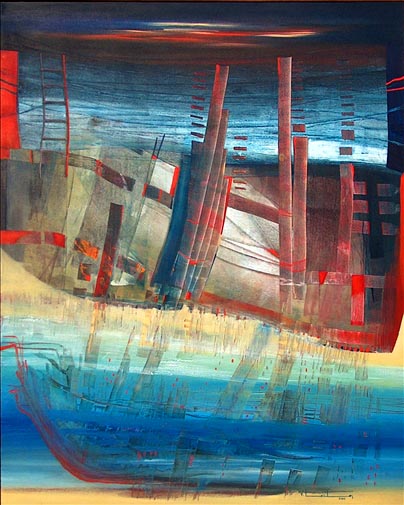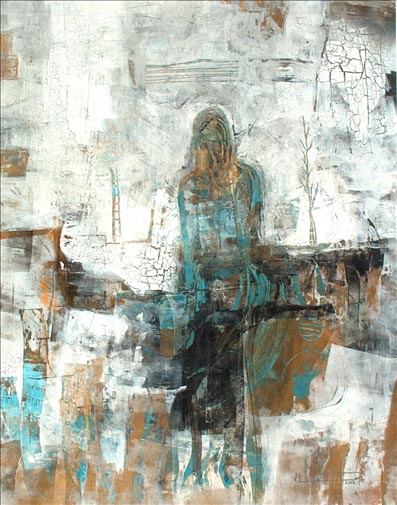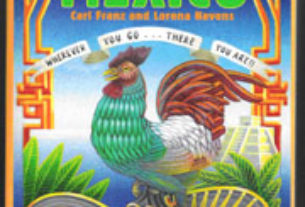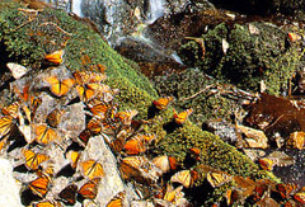Exploring Mexico’s Artists and Artisans
Chihuahua poetry has found a new outlet in the paintings of Verónica Leiton, a 42-year-old Chilean artist who has called Mexico home for more than a decade.
“I have always thought that literature, especially poetry, is full of images (and) metaphors that help extraordinarily with the pictorial imagination,” Leiton says. Thus, this project seemed a natural choice for the artist, whose paintings are fraught with symbolic imagery encapsulated in mysterious, dreamlike landscapes.

Leiton’s artwork seems to serve as an expression of an interior, subconscious world, which is comprised of such intangible elements as emotion and thought. In this way, the painter’s artistic style is similar to the poems that have inspired her series entitled La literatura Chihuahuense a la plástica.
“It is poetry that speaks of landscape, of arid desert, at times of climate,” explains Leiton, who has resided in Ciudad Juárez, Chihuahua for nearly a dozen years. “But they are also poems that speak of feelings like love, indifference, loneliness, nostalgia — universal themes that I believe can be felt and seen anywhere on this planet.”
Thus far, Leiton has completed approximately 40 paintings as part of her series influenced by Chihuahua poetry. She has been working on the series for about a year, although the journey that led her to this point began at an earlier time in her life.
“Between the years of 1997 and 2000, I started to participate in the first state poetry conferences, which incidentally now occur in Ciudad Juárez on an international level,” Leiton recounts. “When the poetry conferences had recently started up, I was part of the team that coordinated (them) and I also participated modestly with some texts.”
Throughout the course of her involvement with the poetry conferences, Leiton began to research the work of some of the participating writers. Realizing the extraordinary level of their talent, she decided to begin a project that would involve these poets and thus, her series La literatura Chihuahuense a la plástica was born.
“When I decided to work with some of (the poets)… the majority accepted immediately,” Leiton says. “It makes for a good project for them and also, they like my work. And for me, it is terrific.”
The texts of 15 different Chihuahua poets have been incorporated into Leiton’s series thus far, including poems by José Vicente Anaya, Arminé Arjona, Jorge Humberto Chávez, Enrique Cortázar, Alfredo Espinosa, Jesús Gardea, Dolores Guadarrama, Carlos Montemayor, Margarita Muñoz, María Merced Najera, Rosario Sanmiguel, Enrique Servín, César Silva, Micaela Solís and Rogelio Treviño.
“All of them are excellent,” Leiton remarks about the poets, explaining that some of their texts have gained recognition not just nationally, but on a global level as well.

And surely Leiton’s project will serve to further draw attention to these talented writers who have sprung forth from her adopted homeland of Chihuahua, Mexico. When viewing the complex, mesmerizing works of art that comprise La Literatura Chihuahuense a la plástica, one can not help but wonder what words influenced the paintings. Thus, Leiton’s series serves as a portal to the poetry that informs it.
Among the poems that have inspired Leiton’s masterful, and at times metaphorical, creations are Cortázar’s XVII and Arjona’s (A Dante Almaraz) that were the basis of the paintings El desierto renace en el mar (The desert is reborn in the sea) and De dantescas proporciones (Of horrific proportions).
When asked about the aforementioned works, Leiton replies “even though I can more or less explain to you what I wanted to express through the painting, I firmly believe that the work should speak for itself. It alone will reflect what one as an artist thinks and feels.”
A glimmer of their underlying significance, however, is glimpsed when Leiton provides brief descriptions of the two paintings.
For instance, she says that her work entitled El desierto renace en el mar is a “visual metaphor,” which was inspired by these verses of Cortázar’s XVII:
Por la noche
El desierto renace en mar
Y al despuntar el alba
El agua y los peces
Regresan,
Asume de nuevo su reseca esencia
De enarenada eternidad.
(Translation)
At night
The desert is reborn in the sea
And at daybreak
The water and the fish
Return,
Once again assuming their parched essence
Of sandy eternity.
The focal point of Leiton’s El desierto renace en el mar is a fish painted in earth tones that contains a series of abstract forms within its outline. Upon closer inspection, these forms seem to take on the appearance of different landscapes, all forming part of the fish’s body. A brown shadow surrounds the fish and stretches up to mingle with the shades of blue that seem to seep down from the top of the painting, which gives the impression of sand mixing with sea.
Leiton describes the painting as a marine image that has been touched by the element of chrome that is found in desert landscapes. “It is almost a contradiction, but it is also about thinking that ultimately, the desert is a great fossilized ocean,” she remarks.
While El desierto renace en el mar reflects upon the natural landscapes of desert and sea, Leiton’s De dantescas proporciones explores the manmade environments of cities and the undercurrent of atrocities that flows through them. The painting is based on these lines from Arjona’s (A Dante Almaraz), which translates as (To Dante Almaraz):
De dantescas proporciones.
Mi ciudad es un negro
lamento
un aullido
infinito
(Translation)
Of horrific proportions.
My city is a black
wail
a howl
without end
This poem’s sentiments are reflected in Leiton’s impressive work that depicts a shadowy city, where gray walls co-exist with barren trees in a gloomy landscape filled with shades of red and black. Shining forth from the gaping darkness in the center of the painting is a ghostly moon from which little pieces appear to be falling off and floating down into the city below. Or perhaps they are tears and the moon is grieving for the sorrow created in the manmade world that it hovers above.
It is significant that the title of the poem on which Leiton’s piece is based is (To Dante Almaraz). This man to whom the poem is dedicated, Dante Almaraz, was a human rights lawyer who was shot to death in Ciudad Juárez in January of 2006.
According to Leiton, her painting “speaks of the atrocities that can arise in a city. It is specifically related to the murders that are taking place not only in Juárez, but in many places around the world.” She then quotes the 14th century Italian poet Dante Alighieri, saying “cities seem to be true hells… destroying themselves, destroying us.”
Yet, it is the work of artists like Leiton and the Chihuahua poets who have inspired her that bring light to the dark corners of these cities that sometimes seem so bleak.
As Leiton says of Ciudad Juárez, “it is a city that I love very much. It has been and will continue to be my home. I have great affection for it and much faith in it… and there are many people working very seriously and nobly here, in solidarity and with social commitment, and contributing to the community.”


